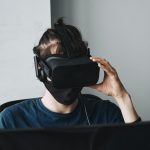Hospitals are the core of our society, helping every individual in various ways be healthy and become the best versions of themselves. So, if hospitals are working so well already why do we need VR? For a very simple reason; hospitals need help to better help us. VR is doing that by helping the chronically ill, helping future and current hospital personnel and a plethora of other ways. Keep reading to find out more about VR helps in the hospital.
Training hospital staff
“There is this huge need to train people up quickly, whether they are in the profession or whether they are coming back to the profession to help during the pandemic.” said Dr. Jack Pottle, a physician in acute and internal medicine and the chief medical officer for OMS (Oxford Medical Simulation).
As we know, during the outbreak of coronavirus hospitals have been in more demand than ever. This also raises the problem that there are not enough nurses, doctors and other hospital staff to support the patients. Health care facilities in America, the UK and Canada have begun to use OMS to quickly train retired nurses, doctors and eventually graduates, so that they can help the patients who are not affected by covid 19. They have successfully trained over 17,000 personnel so far.
Help ease pain
While VR obviously can’t cure any ailments, it certainly can make treatments easier to bear. This is seen through SnowWorld which was created so that burn patients could immerse themselves in a fun and relaxing world which would distract them from the pain of changing dressings.
ReuterEvents states that “the results are somewhat staggering. A patient had two almost identical procedures, for one he was given a Nintendo console to play, for the second he used SnowWorld in VR. When asked how painful each procedure was, the second – performed whilst distracted by VR – showed less than half the level of pain.”
Assisting medical students
VR (through programs such as ImmersiveTouch and Osso VR) enables students to view simulations of real-life crucial operations. This allows students, and surgeons alike, to practice their skills in a no-risk environment. Which has produced better results than traditional classroom teaching, as surgeons trained with VR had a 230% increase in their overall performance than students who were taught in a theory based environment.
Conferences and seminars can also be improved with the addition of VR. As demonstrated through Dr. Spiegel who presented an entire lecture with VR, check out the video below. This kind of content helps combat the tedious nature of regular classroom teaching, which results in a more immersive and long-lasting experience.
More effective physical therapy
Physical therapy is an important aspect of recovery for many patients such as people who have brain injuries, survived a stroke etc. It is imperative to commence the therapy early on in their recovery journey to achieve the best results possible. And this is where VR comes in, with programs such as Neuro Rehab VR, the device provides self-guided and personalised training exercise in a gamified manner to make the recovery process much more enjoyable.
These programs can be applied with VR in Australia today, contact YesVR to see what we can do for you.
Written by Belinda Saha
Similar articles to check out:







